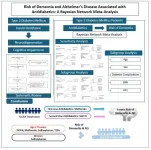(Press-News.org) EL PASO, Texas (July 11, 2024) – Researchers at The University of Texas at El Paso have made significant inroads in understanding how nanoplastics and per- and polyfluoroalkyl substances (PFAS) — commonly known as forever chemicals — disrupt biomolecular structure and function. The work shows that the compounds can alter proteins found in human breast milk and infant formulas — potentially causing developmental issues downstream.
Nanoplastics and forever chemicals are manmade compounds present throughout the environment; a series of recent studies have linked them to numerous negative health outcomes. While nanoplastics originate primarily as a result of the degradation of larger plastic materials, like water bottles and food packaging, forever chemicals are found in various products like cookware and clothing.
The UTEP research team focused on the compounds’ impact on three proteins critical to human development and function: beta-lactoglobulin, alpha-lactalbumin and myoglobin. Their findings, which provide an atomic-level insight into the detrimental effects of nanoplastics and PFAS on human health, are described in two recent articles in the Journal of the American Chemical Society and ACS Applied Materials and Interfaces.
“By understanding the molecular mechanisms of how nanoplastics and forever chemicals disrupt cellular functions, scientists can develop safer alternatives to these materials,” said Mahesh Narayan, Ph.D., a professor, fellow of the Royal Society of Chemistry and chief of the Division of Biochemistry in UTEP’s Department of Chemistry and Biochemistry, who oversaw the two studies. “The insights gained from this research have far-reaching implications.”
Narayan said that, most importantly, their research revealed that nanoplastics and PFAS completely “dissolved” a region of proteins known as the alpha helix, converting them into structures called beta sheets.
“We weren’t expecting them all to have this similar impact on the alpha helix,” Narayan said. “It was a complete coincidence.” The team observed that this alteration also occurs in amyloid proteins, which can cause neurodegeneration and neurotoxic outcomes if the synthetic chemicals reach the brain.
Additional key findings of the studies are described below.
Milk Protein: Beta-Lactoglobulin (BLG)
BLG is a protein found in the milk of sheep and cows and is commonly used as an ingredient in infant formula. The protein binds to retinol (vitamin A) and fatty acids and is crucial for vision and brain development in infants.
The research team discovered that the binding efficiency of BLG to retinol and fatty acids decreases upon exposure to nanoplastics and PFAS. This decrease, modeled by Lela Vukovic, Ph.D., associate professor in the Department of Chemistry and Biochemistry, can lead to significant developmental issues in neonatal infants, the team said.
Additionally, for the first time ever, the team observed that PFAS binds to the milk protein, turning it into a carrier for these compounds.
Human Breast Milk: Alpha-Lactalbumin
Alpha-lactalbumin is found in human breast milk, participates in lactose synthesis and is ingested by infants to help meet nutritional needs. UTEP researchers found that nanoplastics and PFAS corrupt the structure of alpha-lactalbumin protein, thereby potentially compromising lactose formation. The team said the disruption can lead to downstream developmental defects in neonatal infants, such as compromised immunity and reduced mineral absorption.
Oxygen Storage: Myoglobin
Myoglobin, found in the blood and muscle tissue of most mammals, is crucial for storing oxygen. The UTEP research team found that nanoplastics and PFAS compromise the functionality of the myoglobin protein, disrupting its ability to store oxygen. This disruption could lead to health issues such as breathlessness and anemia.
Additional experiments by the team demonstrated that exposure to nanoplastics impairs locomotion in worms, with effects comparable to paraquat — an herbicide that has been tied to causing Parkinson’s disease.
“This work has the potential to significantly impact public health and environmental policies, highlighting the vital role of scientific research in addressing global challenges,” said Robert Kirken, Ph.D., dean of the College of Science. “I am proud of the groundbreaking research conducted by Dr. Narayan, Dr. Vukovic and their teams. Their innovative approach to understanding how these manmade materials disrupt biomolecular functions is a prime example of the transformative work UTEP researchers do on a regular basis.”
Narayan and his research team plan to continue their studies and investigate the effects of other plastics and PFAS compounds.
About The University of Texas at El Paso
The University of Texas at El Paso is America’s leading Hispanic-serving university. Located at the westernmost tip of Texas, where three states and two countries converge along the Rio Grande, 84% of our 24,000 students are Hispanic, and more than half are the first in their families to go to college. UTEP offers 170 bachelor’s, master’s and doctoral degree programs at the only open-access, top-tier research university in America.
END
Nanoplastics and ‘forever chemicals’ disrupt molecular structures, functionality
Both compounds alter critical proteins in breast milk, infant formulas, more, UTEP study shows
2024-07-11
ELSE PRESS RELEASES FROM THIS DATE:
Quadrupolar nuclei measured for the first time by zero-field NMR
2024-07-11
What is the structure of a particular molecule? And how do molecules interact with each other? Researchers interested in those questions frequently use nuclear magnetic resonance (NMR) spectroscopy to find answers. In NMR, a powerful external magnetic field is employed to align the spins of atomic nuclei, which are then induced to rotate by an oscillating weak magnetic field generated by coils. A change in voltage as a result can be converted to measurable frequencies. Based on this, researchers can identify the molecular structures while also revealing ...
UT Arlington research contributes $226 million to U.S. economy
2024-07-11
A new report shows that research projects at The University of Texas at Arlington contributed one quarter of a billion dollars—$226.4 million, to be exact—to the national economy through 797 vendor contracts and subcontracts between 2018 and 2022. Of those contracts, 111 were from small businesses and 87 from minority- or woman-owned businesses.
“Research coming from UT Arlington faculty and students not only helps solve some of society’s most vexing problems, but it is also an important economic driver for business development,” said Kate C. Miller, vice president for research and innovation at UTA. “This report makes clear that UTA research ...
Researchers develop a way to make lifesaving phages accessible, transportable and much easier to use
2024-07-11
The great promise of bacteriophages is that they naturally destroy bacteria, often in situations where antibiotics fail.
Until now, though, there has been no way to access them quickly and efficiently, especially in emergency cases of antibiotic resistant infections.
Researchers at McMaster University, working with a colleague from Université Laval, have developed a simple new way to store, identify, and share phages, making them more accessible to patients who need them.
“Bacteriophages ...
MD Anderson Research Highlights for July 11, 2024
2024-07-11
HOUSTON ― The University of Texas MD Anderson Cancer Center’s Research Highlights provides a glimpse into recent basic, translational and clinical cancer research from MD Anderson experts. These advances are made possible through seamless collaboration between MD Anderson’s world-leading clinicians and scientists, bringing discoveries from the lab to the clinic and back.
Recent developments at MD Anderson offer insights into mechanisms regulating metabolic programming and cellular senescence, ...
Metformin and other antidiabetic drugs can help reduce the risk of dementia in patients with type 2 diabetes
2024-07-11
Ann Arbor, July 11, 2024 – Investigators analyzing the potential cognitive effects of antidiabetic medications in records of more than 1.5 million patients with type 2 diabetes mellitus (T2DM) found risks of dementia and Alzheimer’s disease (AD) were significantly lower in patients treated with metformin and sodium glucose co-transporter-2 inhibitors (SGLT-2i) compared to other antidiabetic drugs. Their results appear in the American Journal of Preventive Medicine, published by Elsevier.
T2DM has become ...
First ever 3D reconstruction of 52,000-year-old woolly mammoth chromosomes thanks to serendipitously freeze-dried skin
2024-07-11
An international research team has assembled the genome and 3D chromosomal structures of a 52,000-year-old woolly mammoth—the first time such a feat has been achieved for any ancient DNA sample. The fossilized chromosomes, which are around a million times longer than most ancient DNA fragments, provide insight into how the mammoth’s genome was organized within its living cells and which genes were active within the skin tissue from which the DNA was extracted. This unprecedented level of structural detail was retained because ...
Climate change: Thick sea ice flowing from Arctic Ocean shortening shipping season in Northwest Passage
2024-07-11
An increased amount of thick sea ice flowing south from the Arctic Ocean shortened the ice-free shipping season in several parts of the Northwest Passage between 2007 and 2021, according to an analysis in Communications Earth & Environment. The authors suggest this could mean the Northwest Passage is unlikely to become a viable alternative to traditional shipping routes, despite previous hopes that it may become viable due to global warming.
The Northwest Passage (NWP) is a commercial shipping route connecting the Atlantic and Pacific Oceans that runs through the Arctic Circle north of North America. Through the Canadian ...
State gun laws have mixed impact on suicide and homicide rates
2024-07-11
DURHAM, N.C. – Certain state gun laws are associated with decreased suicide rates for children under age 18, but the laws have little influence on homicide rates, according to a study from Duke Health researchers examining the relationship between gun laws and child deaths.
Since 2020, firearms rank as the leading cause of death among U.S. children ages 1-18, raising the need for research to help guide prevention efforts.
“Our analysis of suicide and homicide mortality data from ...
Treatment approaches for opioid use disorder offered in us substance use treatment facilities
2024-07-11
About The Study: Substance use treatment facilities reported significant gaps in provision of effective treatments for opioid use disorder (OUD). More than one-third of facilities did not offer medications for OUD (MOUD) and less than half offered multiple MOUD types, limiting MOUD treatment options for patients and clinicians.
Corresponding Author: To contact the corresponding author, Tae Woo Park, M.D., M.Sc., email parkt4@upmc.edu.
To access the embargoed study: Visit our For The Media website at this link https://media.jamanetwork.com/
(doi:10.1001/jama.2024.11913)
Editor’s ...
Secondhand nicotine absorption from E-cigarette vapor vs tobacco smoke in children
2024-07-11
About The Study: In this cross-sectional study of U.S. children, nicotine absorption was much lower in children who were exposed to secondhand vapor versus secondhand smoke, but higher than in those exposed to neither. These findings suggest that switching from smoking to vaping indoors may substantially reduce, but not eliminate, children’s secondhand exposure to nicotine and other noxious substances.
Corresponding Author: To contact the corresponding author, Harry Tattan-Birch, Ph.D., email h.tattan-birch@ucl.ac.uk.
To ...
LAST 30 PRESS RELEASES:
Making lighter work of calculating fluid and heat flow
Normalizing blood sugar can halve heart attack risk
Lowering blood sugar cuts heart attack risk in people with prediabetes
Study links genetic variants to risk of blinding eye disease in premature infants
Non-opioid ‘pain sponge’ therapy halts cartilage degeneration and relieves chronic pain
AI can pick up cultural values by mimicking how kids learn
China’s ecological redlines offer fast track to 30 x 30 global conservation goal
Invisible indoor threats: emerging household contaminants and their growing risks to human health
Adding antibody treatment to chemo boosts outcomes for children with rare cancer
Germline pathogenic variants among women without a history of breast cancer
Tanning beds triple melanoma risk, potentially causing broad DNA damage
Unique bond identified as key to viral infection speed
Indoor tanning makes youthful skin much older on a genetic level
Mouse model sheds new light on the causes and potential solutions to human GI problems linked to muscular dystrophy
The Journal of Nuclear Medicine ahead-of-print tip sheet: December 12, 2025
Smarter tools for peering into the microscopic world
Applications open for funding to conduct research in the Kinsey Institute archives
Global measure underestimates the severity of food insecurity
Child survivors of critical illness are missing out on timely follow up care
Risk-based vs annual breast cancer screening / the WISDOM randomized clinical trial
University of Toronto launches Electric Vehicle Innovation Ontario to accelerate advanced EV technologies and build Canada’s innovation advantage
Early relapse predicts poor outcomes in aggressive blood cancer
American College of Lifestyle Medicine applauds two CMS models aligned with lifestyle medicine practice and reimbursement
Clinical trial finds cannabis use not a barrier to quitting nicotine vaping
Supplemental nutrition assistance program policies and food insecurity
Switching immune cells to “night mode” could limit damage after a heart attack, study suggests
URI-based Global RIghts Project report spotlights continued troubling trends in worldwide inhumane treatment
Neutrophils are less aggressive at night, explaining why nighttime heart attacks cause less damage than daytime events
Menopausal hormone therapy may not pose breast cancer risk for women with BRCA mutations
Mobile health tool may improve quality of life for adolescent and young adult breast cancer survivors
[Press-News.org] Nanoplastics and ‘forever chemicals’ disrupt molecular structures, functionalityBoth compounds alter critical proteins in breast milk, infant formulas, more, UTEP study shows







